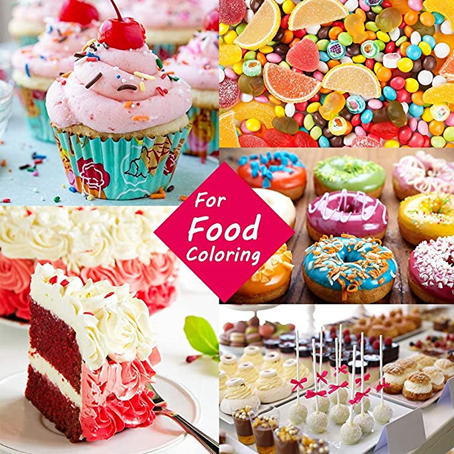The Art of Food Colouring: Enhancing Visual Appeal in Foods and Beverages
15 Jun 2023
 Food colouring comes in many forms consisting of liquids, powders, and gels. Besides that, food colouring consists of two types: Synthetic (Brilliant Blue FCF, Tartrazine) and Natural (ex: beetroot, turmeric). Synthetic colouring is chemically produced while natural colouring is often extracted from plant, animal, or mineral sources. As a result, synthetic colouring is often more vibrant and stable than natural colouring. This, however, does not affect the taste of your food.
Food colouring comes in many forms consisting of liquids, powders, and gels. Besides that, food colouring consists of two types: Synthetic (Brilliant Blue FCF, Tartrazine) and Natural (ex: beetroot, turmeric). Synthetic colouring is chemically produced while natural colouring is often extracted from plant, animal, or mineral sources. As a result, synthetic colouring is often more vibrant and stable than natural colouring. This, however, does not affect the taste of your food.
Regulation 21 of the Malaysia Food Regulation 1985 stated that the substances listed in Table I and Table II shall be the permitted colouring substances within the meaning and for the purposes of these Regulations and only the substances specified in Table III to the Seven Schedule shall be the permitted diluent. Furthermore, colouring preparations must contain a minimum of 4 per cent of permitted colouring substance. Benzoic acid, which is an approved preservative, may be present in liquid form colouring preparation in amounts not greater than 400 mg/kg, together with acidity regulators, which are a permitted food conditioner. We must double check with the CODEX Standard for Food Additives because the maximum usage level of food colouring depends on the specified products produced.
It is crucial to note that excessive consumption of some synthetic food colouring has been linked to possible health issues, such as hyperactivity in children or allergic reactions in sensitive individuals. Thus nowadays, the demand for natural food colouring options is growing rapidly due to consumer preferences for clean-label products such as fruit and vegetable juices, plant extracts, and other natural colour sources.
By understanding the various types of food coloring, exploring natural alternatives, and considering the regulations associated with their usage, we can elevate the art of food coloring and create visually stunning culinary masterpieces.

Apparently, “We eat with our eyes.” Foods that are off-colour are typically thought to be of lower quality, which is why colours are added. Food colouring, also known as food additives or food dyes, are any substances used to impart or enhance colour to food and includes colouring preparation.
 Food colouring comes in many forms consisting of liquids, powders, and gels. Besides that, food colouring consists of two types: Synthetic (Brilliant Blue FCF, Tartrazine) and Natural (ex: beetroot, turmeric). Synthetic colouring is chemically produced while natural colouring is often extracted from plant, animal, or mineral sources. As a result, synthetic colouring is often more vibrant and stable than natural colouring. This, however, does not affect the taste of your food.
Food colouring comes in many forms consisting of liquids, powders, and gels. Besides that, food colouring consists of two types: Synthetic (Brilliant Blue FCF, Tartrazine) and Natural (ex: beetroot, turmeric). Synthetic colouring is chemically produced while natural colouring is often extracted from plant, animal, or mineral sources. As a result, synthetic colouring is often more vibrant and stable than natural colouring. This, however, does not affect the taste of your food.
Food colouring can be added to a wide range of food products, including processed foods, beverages, confectionary, baked goods, dairy products, sauces, dressings, and processed foods. Food colouring aids in the production of colourful candies, eye-catching icing, tasty baked goods, attractive beverages, and visually appealing snacks.
Regulation 21 of the Malaysia Food Regulation 1985 stated that the substances listed in Table I and Table II shall be the permitted colouring substances within the meaning and for the purposes of these Regulations and only the substances specified in Table III to the Seven Schedule shall be the permitted diluent. Furthermore, colouring preparations must contain a minimum of 4 per cent of permitted colouring substance. Benzoic acid, which is an approved preservative, may be present in liquid form colouring preparation in amounts not greater than 400 mg/kg, together with acidity regulators, which are a permitted food conditioner. We must double check with the CODEX Standard for Food Additives because the maximum usage level of food colouring depends on the specified products produced.
It is crucial to note that excessive consumption of some synthetic food colouring has been linked to possible health issues, such as hyperactivity in children or allergic reactions in sensitive individuals. Thus nowadays, the demand for natural food colouring options is growing rapidly due to consumer preferences for clean-label products such as fruit and vegetable juices, plant extracts, and other natural colour sources.
By understanding the various types of food coloring, exploring natural alternatives, and considering the regulations associated with their usage, we can elevate the art of food coloring and create visually stunning culinary masterpieces.


